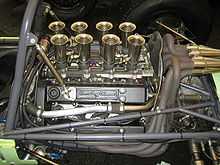Walter Hassan
Walter Hassan OBE, C.Eng., M.I. Mech.E.(1905–1996) was a distinguished UK automotive engineer[1] who took part in the design and development of three very successful engines: Jaguar XK, Coventry Climax and Jaguar V12 as well as the ERA racing car.
Walter Thomas Frederick Hassan was born in London 25 April 1905. His father, of Irish descent, owned a clothes store in Holloway, North London. His natural interest was always in mechanical things.[2] As it was told, his uncle encouraged him to be a creator since his uncle was building model ships.
He studied at Northern Polytechnic (now the University of North London) and then Hackney Technical Institute of Engineering.[1] The Regent Street Polytechnic has also been named.[2]
Bentley
Hassan's first job was as a 15 yr-old[2] shop boy in W. O. Bentley's newly founded Bentley Motors,[1] employee #14. He was a fitter in the engine shop then in the chassis shop gaining a complete experience of the 3 litre cars then in production.
He eventually moved to road testing working under the head of experimental department (Today's R&D) Frank Clement, the company's professional racing driver, and was a riding mechanic in some races. Off-season he was part of the Bentley Motors service department.
Establishing himself as the best Bentley mechanic he was allotted to Woolf Barnato, their top driver and Bentley Motors chairman and shareholder. They established a close and lasting friendship.[2]
After it was put into liquidation and taken over by Rolls-Royce Limited at the end of 1931 Hassan left Bentley Motors and worked for Barnato. In 1933 he started to build a racing car, it would become known as Barnato Hassan, and was one of the fastest cars ever to lap Brooklands. Later he developed a car for Bill Pacey, named Pacey Hassan. It was a success on the British racing circuits in the 1936 season. By now he had become a family man and accordingly sought out more stable employment.[1] He had married in 1933 and they were to have four children.
ERA

Hassan then spent time at Raymond Mays' ERA at Bourne in Lincolnshire working there with Peter Berthon on engine development and at Brooklands with Thompson and Taylor on ERA chassis development.[2]
The vast majority of prewar ERAs are still in existence, and they have continuous and verifiable provenance. They still compete in historic events despite the youngest being nearly seventy years old.
Jaguar

In 1938 he joined SS Cars Ltd, later Jaguar Cars, as chief R&D engineer at Coventry. When the war started he moved to Bristol and worked on engine development for the Bristol Engine Company. At the end of the war he returned to Coventry to continue to work with Bill Heynes on what became their XK engine.
This engine remained in production with various displacements from 1948 until 1992.
It powered the winning car at Le Mans in 1951, 1953, 1955 and 1957.
Coventry Climax

In 1950 Hassan joined Harry Mundy at Coventry Climax, and they with Claude Baily designed the FW series (featherweight) lightweight overhead camshaft engine intended for fire pumps but further developed for motor racing.
In Colin Chapman's cars they had great successes in the Le Mans 24 Hours, Formula 2 and Formula 1 twice bringing the world championship to Jim Clark and Team Lotus.
This engine was also used in cars like the Lotus Elite.
Jaguar V12

Coventry Climax was bought by Jaguar in 1963 and, now back with Bill Heynes, Heynes Hassan and the Coventry Climax team developed a Jaguar V12 engine.[3]
In later years, Le Mans-winning Jaguars were powered with this V12 engine.
A 7.0-litre V12 based on the production 5.3-litre engine powered the winning Jaguar XJR-9 in June 1988.
A Jaguar XJR-12 powered by a 7 L 60 degree SOHC V12 won in June 1990. During that race it covered 4882.4 km at an average speed of 204.036 km/h / 126.782 mph with a maximum trap speed of 353 km/h / 219 mph.
Retirement
Hassan retired on 28 April 1972 at the age of 67[1] and was awarded the OBE for his services to motor sport. He married Ethel Murray in 1933, they had a daughter and three sons. After Ethel's death he lived with his son Bill at Kenilworth though he later moved to the Motor Industries Benevolent Home and died at Easenhall Warwickshire 12 July 1996 aged 91 years.